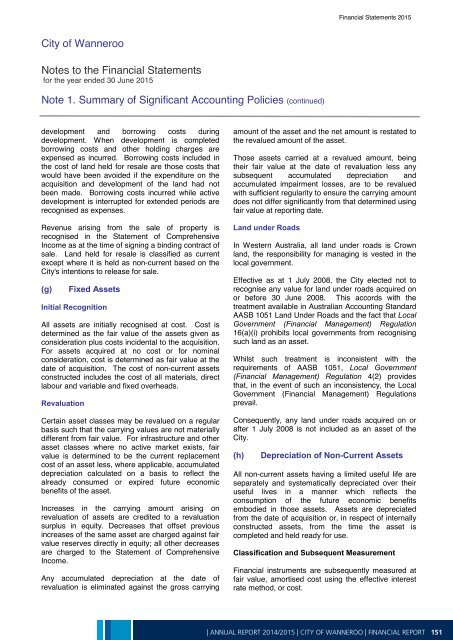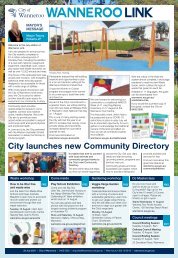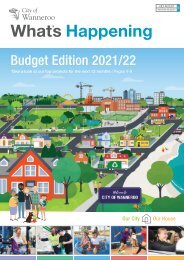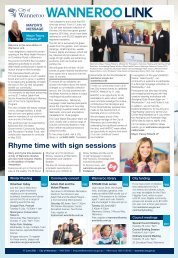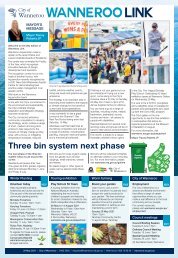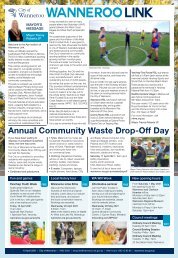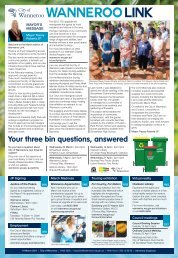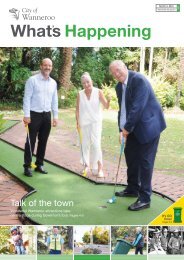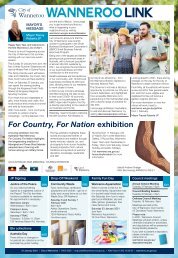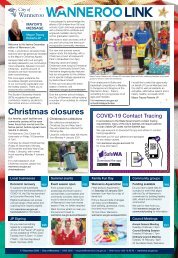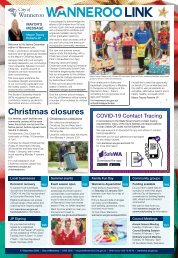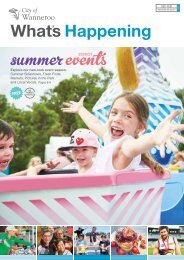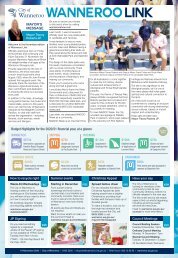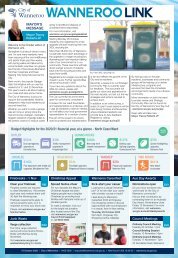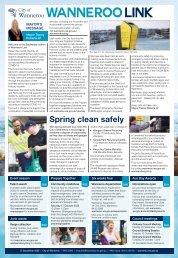Create successful ePaper yourself
Turn your PDF publications into a flip-book with our unique Google optimized e-Paper software.
Financial Statements 20<strong>15</strong><br />
City of Wanneroo<br />
Notes to the Financial Statements<br />
for the year ended 30 June 20<strong>15</strong><br />
Note 1. Summary of Significant Accounting Policies (continued)<br />
development and borrowing costs during<br />
development. When development is completed<br />
borrowing costs and other holding charges are<br />
expensed as incurred. Borrowing costs included in<br />
the cost of land held for resale are those costs that<br />
would have been avoided if the expenditure on the<br />
acquisition and development of the land had not<br />
been made. Borrowing costs incurred while active<br />
development is interrupted for extended periods are<br />
recognised as expenses.<br />
Revenue arising from the sale of property is<br />
recognised in the Statement of Comprehensive<br />
Income as at the time of signing a binding contract of<br />
sale. Land held for resale is classified as current<br />
except where it is held as non-current based on the<br />
City's intentions to release for sale.<br />
(g)<br />
Fixed Assets<br />
Initial Recognition<br />
All assets are initially recognised at cost. Cost is<br />
determined as the fair value of the assets given as<br />
consideration plus costs incidental to the acquisition.<br />
For assets acquired at no cost or for nominal<br />
consideration, cost is determined as fair value at the<br />
date of acquisition. The cost of non-current assets<br />
constructed includes the cost of all materials, direct<br />
labour and variable and fixed overheads.<br />
Revaluation<br />
Certain asset classes may be revalued on a regular<br />
basis such that the carrying values are not materially<br />
different from fair value. For infrastructure and other<br />
asset classes where no active market exists, fair<br />
value is determined to be the current replacement<br />
cost of an asset less, where applicable, accumulated<br />
depreciation calculated on a basis to reflect the<br />
already consumed or expired future economic<br />
benefits of the asset.<br />
Increases in the carrying amount arising on<br />
revaluation of assets are credited to a revaluation<br />
surplus in equity. Decreases that offset previous<br />
increases of the same asset are charged against fair<br />
value reserves directly in equity; all other decreases<br />
are charged to the Statement of Comprehensive<br />
Income.<br />
Any accumulated depreciation at the date of<br />
revaluation is eliminated against the gross carrying<br />
amount of the asset and the net amount is restated to<br />
the revalued amount of the asset.<br />
Those assets carried at a revalued amount, being<br />
their fair value at the date of revaluation less any<br />
subsequent accumulated depreciation and<br />
accumulated impairment losses, are to be revalued<br />
with sufficient regularity to ensure the carrying amount<br />
does not differ significantly from that determined using<br />
fair value at reporting date.<br />
Land under Roads<br />
In Western Australia, all land under roads is Crown<br />
land, the responsibility for managing is vested in the<br />
local government.<br />
Effective as at 1 July 2008, the City elected not to<br />
recognise any value for land under roads acquired on<br />
or before 30 June 2008. This accords with the<br />
treatment available in Australian Accounting Standard<br />
AASB 1051 Land Under Roads and the fact that Local<br />
Government (Financial Management) Regulation<br />
16(a)(i) prohibits local governments from recognising<br />
such land as an asset.<br />
Whilst such treatment is inconsistent with the<br />
requirements of AASB 1051, Local Government<br />
(Financial Management) Regulation 4(2) provides<br />
that, in the event of such an inconsistency, the Local<br />
Government (Financial Management) Regulations<br />
prevail.<br />
Consequently, any land under roads acquired on or<br />
after 1 July 2008 is not included as an asset of the<br />
City.<br />
(h)<br />
Depreciation of Non-Current Assets<br />
All non-current assets having a limited useful life are<br />
separately and systematically depreciated over their<br />
useful lives in a manner which reflects the<br />
consumption of the future economic benefits<br />
embodied in those assets. Assets are depreciated<br />
from the date of acquisition or, in respect of internally<br />
constructed assets, from the time the asset is<br />
completed and held ready for use.<br />
Classification and Subsequent Measurement<br />
Financial instruments are subsequently measured at<br />
fair value, amortised cost using the effective interest<br />
rate method, or cost.<br />
page 14<br />
| ANNUAL REPORT <strong>2014</strong>/20<strong>15</strong> | CITY OF WANNEROO | FINANCIAL REPORT<br />
<strong>15</strong>1


